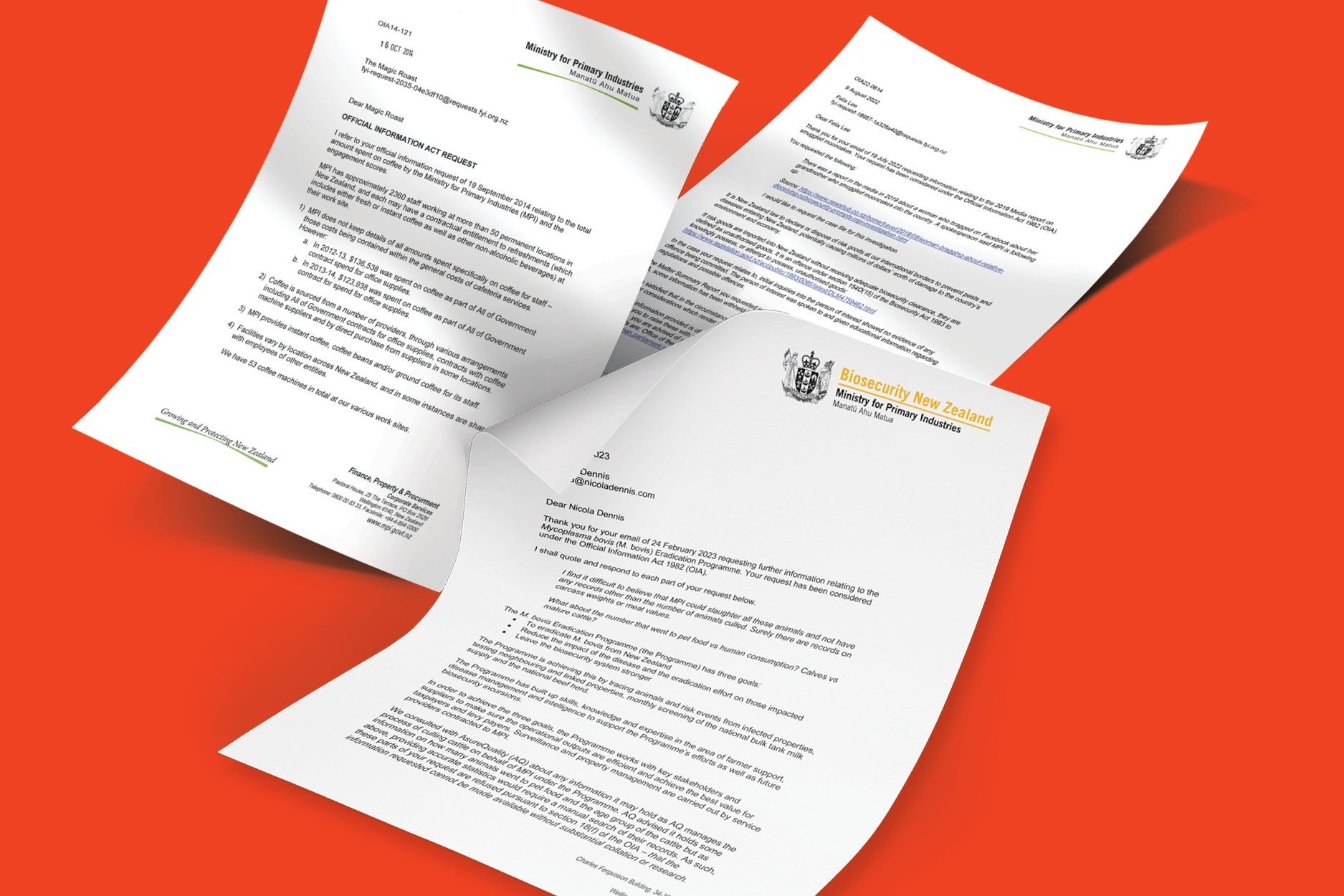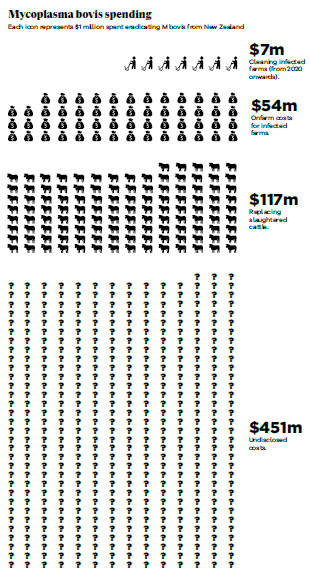MPI and the OIA process
The OIA to MPI is back and it lacks basic information on the Mycoplasma bovis eradication programme. Dr Nicola Dennis explores the OIA process and the unanswered questions.

My official information act (OIA) request is back from the Ministry for Primary Industries (MPI). It’s taken three months for them to consider my basic questions on the Mycoplasma bovis (M bovis) eradication programme. How much did it cost? Where did the money go? Can I have some simple statistics (age and weight) of cattle slaughtered and where they went (pet or human food)? To be clear, I never meant to make any OIA requests at all. I just asked MPI for information, but they have elected to raise an OIA on my behalf. The whole process yielded very little information. But before we get into that, let’s explore what an OIA is and how it is meant to work.
WHAT IS THE OIA?
The year was 1982. If I have googled correctly, then Olivia Newton-John’s “Physical” and Survivor’s “Eye of the Tiger” were battling it out in the charts. Muldoon had swept through the land and frozen everything: wages, prices and ankles (judging by the leg warmers). But the NZ government still found the time to create the Official Information Act of 1982 which declared that (for the most part), official information belonged to the public and should be freely shared with kiwis willing to ask for it. This was a complete change in vibe from the preceding Official Secrets Act of 1951, which threatened to prosecute any public servants who disclosed information without specific authorisation.
The OIA allows anyone in NZ to request information from a government department unless said government department has a decent reason not to. There are about 40 good reasons to choose from, mostly focused on protecting national security, the judicial system, individuals’ privacy and things that would unduly influence the economy.
Your snooping is not limited to government departments. There is also a sister law called the Local Government Official Information and Meetings Act 1987, which means you can also poke around information from community boards, state education authorities, licensing trusts, airports, councils, etc. And you are allowed to violate your own privacy (or someone else’s with their permission). So, if you are in a scab-picking mood, you can also ask the Police, Oranga Tamariki, etc, for the information that they hold on you.
I OIA YOU
Ready to flex your OIA powers? The first step is to pick your department and your question. If you are stuck for inspiration, there is a website called FYI.org.nz where people can share their OIA requests. From here you can view all OIA-able authorities and look up previous requests. Want to know how many Koru club memberships Pamu/Landcorp hold at AirNZ? Wish to view the parking receipts of the mayor of Porirua City? Heard a rumour that MPI is investigating someone’s grandmother for smuggling mooncakes through the border? FYI.org.nz has already got the official answer. You can make your own OIA requests, if you don’t mind it being on the website for the world to see.
If you want to make a private request, the Ombudsman has a helpful “Making official information requests – a guide for requesters” document on their website (ombudsman.parliament.nz) with a helpful email template to copy. Had I known I was about to OIA anyone, I would have totally read this first. They say the key is to be as specific as possible about the information requested. They also outline the timelines. From the moment the request is made, the department receiving the request has seven working days to ask for clarification, 10 working days to transfer the request if it has been made to the wrong department, 20 working days to deliver the request or issue itself an extension. The Ombudsman is where you go to complain if you are unhappy with the OIA process…if you don’t have a national magazine to vent your spleen in. HOW MUCH DID THE M BOVIS PROGRAMME COST AND WHAT WAS THE MONEY SPENT ON?
What did my OIA actually yield? We will start with the easiest one first, because MPI did actually give me some information on this. MPI states that as of February 2023, it had spent $629 million on the eradication of M bovis. Of this, $117.2m was compensation for slaughtered animals, $54m was other forms of on-farm compensation (feed costs, etc), $7m was for farm cleaning costs from 2020 onwards. Prior to this, cleaning costs were not separately recorded by their third party provider (presumably AsureQuality, whose annual reports attribute more than $30m/year to M bovis revenue during 2018 to 2020). That leaves $451m of other costs that I have no information about. I guess I should have asked about testing costs and salaries and research costs. My bad.
WHAT PAYMENTS WERE MADE TO MEAT PROCESSING COMPANIES FOR DISPOSING OF INFECTED STOCK?
This might seem like an odd question to ask. Whatever the meat companies were paid, I am sure they were worth it. It’s not normal for quarantined animals to be funnelled towards human consumption, and the meat companies didn’t really want a bar of it. The extra cleaning and paperwork held things up, and they were being asked to kill undersized stock which didn’t exactly sweeten the deal. The thing is, the meat companies were happy to disclose that they had received payments for slaughtering stock, but MPI has tried on numerous occasions to tell me it didn’t happen. MPI has triggered a sibling-reflex in me; I really only want to know because they don’t want me to know.
Anyway, the latest in this is that they didn’t tell me because I used the word “compensation” and paying processor fees is not, in their view, compensation. Or, in their words: “…as no compensation has been paid to meat processors, without knowing the exact content of your discussions with these companies, we assume they may be referring to higher processing fees paid by MPI in the initial stages of the response. These fees were paid to cover additional costs incurred to dispose of infected animals safely.” Cool. But how much did you pay meat processors?
WHAT INFORMATION DOES THE PROGRAMME HOLD ON THE CATTLE SLAUGHTERED?
Apparently I am to be assured that information on the age-group and destination of infected animals was recorded by AsureQuality. But, the information is not centrally recorded and it is not reasonable to ask AsureQuality to manually search through 2856 compensation claims or 3000 RFID scan files to find the answer. Reasonable is in the eye of the beholder, but that wasn’t what I asked AsureQuality to do. I actually requested that they anonymise the scan files so I could compile the information myself. If you think I wouldn’t crunch through 3000 scan files, then you haven’t met me. That is a data scientist’s idea of a fun afternoon.
But, I think it is worth pausing to wonder why AsureQuality hasn’t recorded this data in a central location. How on earth did this information not find its way into the NAIT database?
Does NAIT not exist to centrally record the movements of infected animals? How on earth can nobody pull the data on where 186,000 confiscated cattle went? Or how old they were when they went there? Surely to goodness someone was tracking these animals and making sure they got to where they were supposed to be, right?
Even more curiously, AsureQuality ”were unable to find any information regarding the carcaseweights or meat values of the culled cattle”, and “Compensation is assessed for destroyed stock by taking the market value of the animal at the point of cull (based on a valuation by either PGG, Alliance or Progressive which does not always record weights) and deducting any meat payment received in sending the animal to the abattoir.”
OK, I understand this to a degree. They would not have the carcaseweights of every single animal. Especially not the ones that allegedly went into landfill. And I can understand that the compensation (and therefore the main focus) was based on the difference between the replacement value and the salvage value of the stock. Maybe it is not strictly necessary to record all the raw numbers that led to the compensation value. But I would have thought that one would hold on to kill sheets for auditing purposes. And if you didn’t, you can be damn sure that the major meat processors did. So why then is there not any kill information at hand?
WHERE TO FROM HERE?
Is it all done and dusted and I am raking over old coals? Should we just sit back and assume the money was well spent? I vote no. The OIA was designed so that Jo Public could hold authorities accountable. So I guess I fire up the email and ask them very specific questions.
How many animals do you know for sure went to meat processors? How much money (money – money not “compensation”) was paid to meat processors for the purposes of disposing of infected stock? What was the total cost spent on testing? Staff remuneration (assuming the word “remuneration” is specific enough)? Research costs?
Yours sincerely, Nicola.
- Nicola Dennis is a scientist, farmer and data wrangler.




